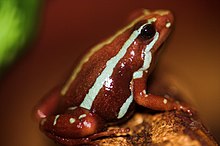| Epipedobates | |
|---|---|

| |
| Epipedobates tricolor | |
| Scientific classification | |
| Domain: | Eukaryota |
| Kingdom: | Animalia |
| Phylum: | Chordata |
| Class: | Amphibia |
| Order: | Anura |
| Family: | Dendrobatidae |
| Subfamily: | Colostethinae |
| Genus: | Epipedobates Myers, 1987 |
| Type species | |
| Prostherapis tricolor Boulenger, 1899 | |
| Diversity | |
| 7 species (see text) | |
Epipedobates is a genus of poison dart frogs native to northern South America (Colombia and Ecuador) west of the Andes, including the western slopes. Common name phantasmal poison frogs has been suggested for the genus.
Taxonomy
Epipedobates was erected in 1987 in an attempt to split dendrobatids into monophyletic genera, accommodating species that had until then been placed in Phyllobates. In the major revision of poison dart frogs in 2006, most of the species formerly placed in Epipedobates were then transferred to Ameerega, leaving behind just five species. The species count of Epipedobates had increased to seven by early 2024.
Description
Dorsal colouration is cryptic, brown. A pale oblique lateral stripe is present. Dorsal skin is smooth or with irregularly scattered granules or tubercles, most distinct and prevalent posteriorly. In adult males, third finger is swollen.
Species
There are seven species:
| Image | Scientific name | Common name | Distribution |
|---|---|---|---|
 |
Epipedobates anthonyi (Noble, 1921) | Anthony's poison arrow frog | Ecuador and Peru. |
| Epipedobates boulengeri (Barbour, 1909) | marbled poison frog or marbled poison-arrow frog | Colombia (Cauca, Nariño, Valle del Cauca Departments, including Gorgona Island) and northwestern Ecuador | |
 |
Epipedobates espinosai (Funkhouser, 1956) | Ecuador | |
| Epipedobates machalilla (Coloma, 1995) | West Ecuador | ||
| Epipedobates maculatus (Peters, 1873) | Confusing Poison Frog | Panama | |
| Epipedobates narinensis (Mueses-Cisneros, Cepeda-Quilindo, and Moreno-Quintero, 2008) | Colombia | ||
 |
Epipedobates tricolor (Boulenger, 1899) | Phantasmal poison frog | Ecuador |
References
- ^ Frost, Darrel R. (2024). "Epipedobates Myers, 1987". Amphibian Species of the World: an Online Reference. Version 6.2. American Museum of Natural History. Retrieved 17 June 2024.
- ^ Grant, T.; Frost, D. R.; Caldwell, J. P.; Gagliardo, R.; Haddad, C. F. B.; Kok, P. J. R.; Means, D. B.; Noonan, B. P.; Schargel, W. E. & Wheeler, W. C. (2006). "Phylogenetic systematics of dart-poison frogs and their relatives (Amphibia: Athesphatanura: Dendrobatidae)" (PDF). Bulletin of the American Museum of Natural History. 299: 1–262. doi:10.1206/0003-0090(2006)299[1:PSODFA]2.0.CO;2. S2CID 82263880. Archived from the original (PDF) on 2009-02-26. Retrieved 2008-09-22.
- "Dendrobatidae". AmphibiaWeb: Information on amphibian biology and conservation. . Berkeley, California: AmphibiaWeb. 2015. Retrieved 17 April 2015.
- Noble, Gladwyn Kingsley (30 Dec 1921). "Five new species of Salientia from South America". American Museum Novitates (29): 1–7. hdl:2246/4615.
- Barbour, Thomas (1909). "Corrections regarding the names of two recently described Amphibia Salientia" (PDF). Proceedings of the Biological Society of Washington. 22: 89.
- Barbour, Thomas (1905). "The Vertebrata of Gorgona Island, Colombia: Reptilia; Amphibia". Bulletin of the Museum at Harvard College. 46 (5): 98–102.
- Funkhouser, John W. (17 September 1956). "New frogs from Ecuador and southwestern Colombia". Zoologica: Scientific Contributions of the New York Zoological Society. 41 (9): 73–80. doi:10.5962/p.190356. S2CID 90986498 – via Biodiversity Heritage Library.
- Coloma, Luis A. (13 September 1995). "Ecuadorian frogs of the genus Colostethus (Anura: Dendrobatidae)". University of Kansas Natural History Museum. 87: 1–72 – via Biodiversity Heritage Library.
- Mueses-Cisneros, Jonh Jairo; Cepeda-Quilindo, Belisario; Moreno-Quintero, Viviana (2008). "Una nueva especie de Epipedobates (Anura: Dendrobatidae) del suroccidente de Colombia". Papéis Avulsos de Zoologia. 48 (1). doi:10.1590/s0031-10492008000100001. ISSN 0031-1049.
- Boulenger, G.A. (December 1899). "LII—Descriptions of new Reptiles and Batrachians collected by Mr. P. O. Simons in the Andes of Ecuador". Annals and Magazine of Natural History. 4 (24): 454–457. doi:10.1080/00222939908678229. ISSN 0374-5481.
| Taxon identifiers | |
|---|---|
| Epipedobates | |